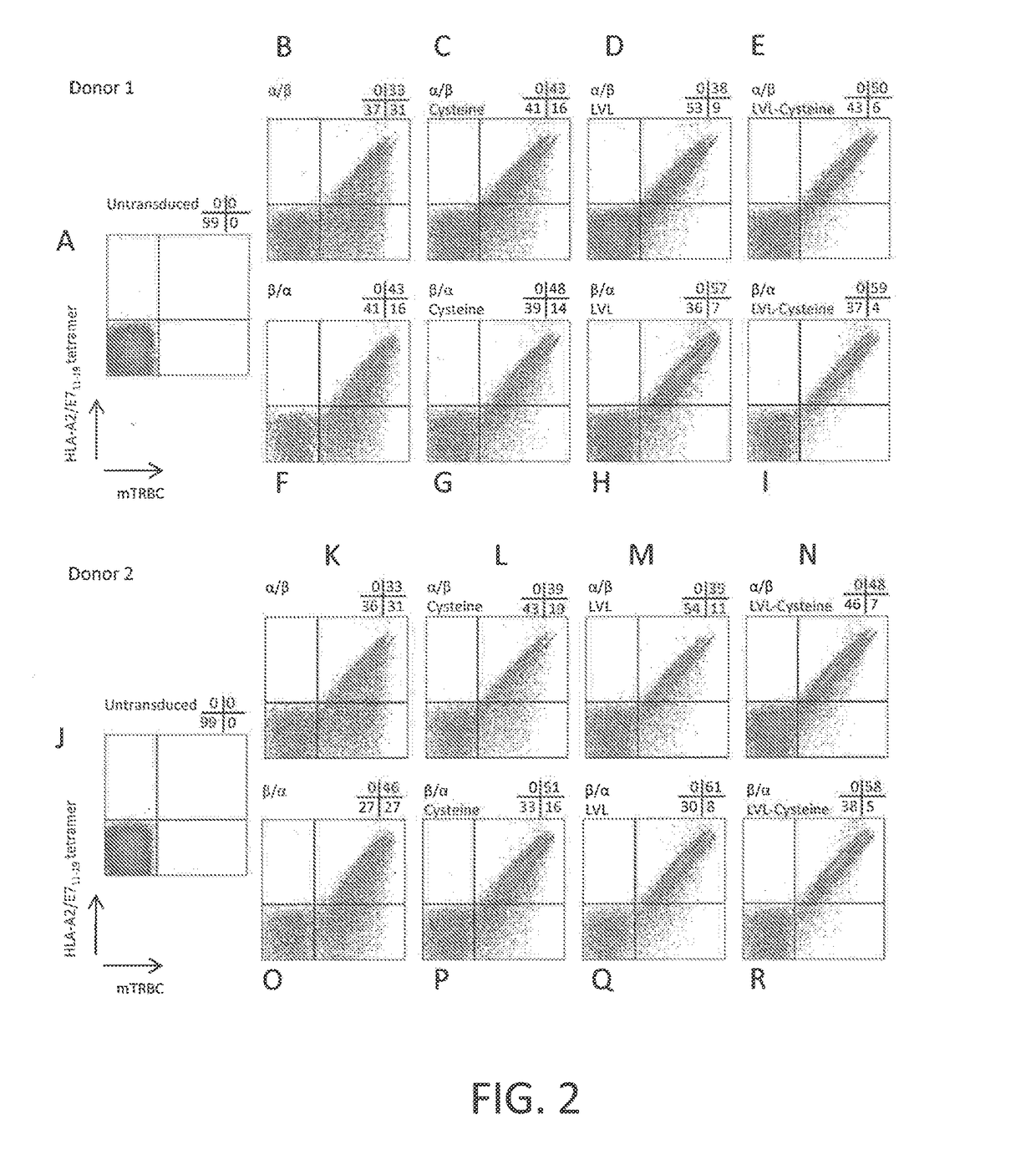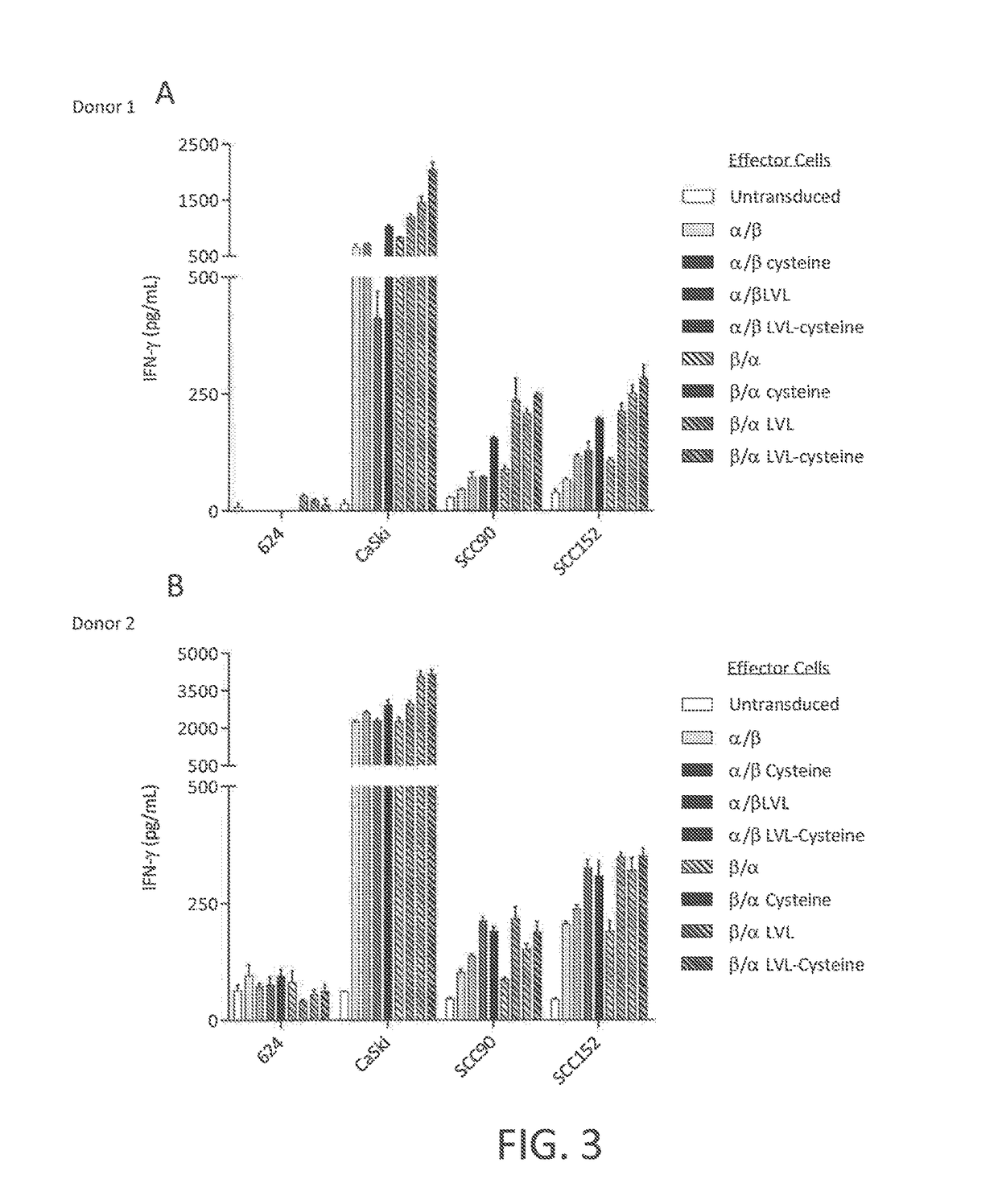Anti-human papillomavirus 16 e7 t cell receptors
a human papillomavirus and receptor technology, applied in the direction of immunoglobulins, peptides, drugs against animals/humans, etc., can solve the problems of poor prognosis of many cancers, including hpv-associated cancers
- Summary
- Abstract
- Description
- Claims
- Application Information
AI Technical Summary
Benefits of technology
Problems solved by technology
Method used
Image
Examples
example 1
[0111]This example demonstrates the isolation of a human anti-HPV 16 E7 TCR from neoplasia.
[0112]Samples of lymphocytes from HPV 16-positive cervical intraepithelial neoplasia (CIN) II / III were obtained from fourteen patients. The patients had previously received various vaccines targeting HPV 16 E7. Numbers of cervix infiltrating lymphocytes (CIL) were expanded using the Rapid Expansion Protocol (REP) as previously described (Dudley et al. J. Immunother. 26:332-42 (2003) and Riddell et al. J. Immunol. Methods 128:189-201 (1990)). Briefly, TIL were cultured with irradiated (40 Gy) allogeneic peripheral blood mononuclear “feeder” cells in complete medium (CM) with 30 ng / mL anti-CD3 antibody and 6000 IU / mL IL-2. The expanded numbers of CIL were screened for HPV 16 E7 reactivity by measuring interferon (IFN)-γ secretion following co-culture with autologous dendritic cells (DCs) pulsed with gp100 peptide, a pool of 15-mer E6 peptides that overlap by 11 amino acid residues and which span...
example 2
[0115]This example demonstrates that peripheral blood T cells transduced to express a chimeric anti-HPV 16 E7 TCR comprising a human variable region and a mouse constant region displayed CD8-independent binding to HLA-A2 / E711-19 tetramer and recognized HLA-A2+ HPV-16+ tumor lines.
[0116]An MSGV1 recombinant expression vector comprising nucleotide sequences encoding a chimeric anti-HPV 16 E7 TCR comprising a human variable region derived from the wild-type, human TCR of Example 1 and a mouse constant region was prepared as follows. The nucleotide sequences in the recombinant expression vector encoded the variable region of the α chain and the variable region of the β chain of the TCR of Example 1, with the exception that an alanine was substituted for the native glycine in the second position of the variable region of the β chain (the leader sequence) in order to provide a Ncol restriction site and Kozak sequence in the recombinant expression vector. Nucleotide sequences encoding a mu...
example 3
[0119]This example demonstrates a method of making a chimeric anti-HPV 16 E7 TCR comprising a human variable region and a mouse constant region, wherein three native amino acid residues in the transmembrane (TM) region of the constant region of the α chain of the TCR are each substituted with a hydrophobic amino acid residue.
[0120]A nucleotide sequence encoding a chimeric TCR comprising a human variable region and a mouse constant region, wherein three native amino acid residues in the transmembrane (TM) region of the constant region of the α chain of the TCR are each substituted with a hydrophobic amino acid residue, was prepared as follows. The nucleotide sequences encoding the α and β chains of the chimeric TCR of Example 2 were cloned into a single nucleotide sequence with the nucleotide sequence encoding the β chain positioned 5′ of the nucleotide sequence encoding the alpha chain and a nucleotide sequence encoding a picornavirus 2A peptide (SEQ ID NO: 28) positioned between th...
PUM
| Property | Measurement | Unit |
|---|---|---|
| Antigenicity | aaaaa | aaaaa |
Abstract
Description
Claims
Application Information
 Login to View More
Login to View More - R&D
- Intellectual Property
- Life Sciences
- Materials
- Tech Scout
- Unparalleled Data Quality
- Higher Quality Content
- 60% Fewer Hallucinations
Browse by: Latest US Patents, China's latest patents, Technical Efficacy Thesaurus, Application Domain, Technology Topic, Popular Technical Reports.
© 2025 PatSnap. All rights reserved.Legal|Privacy policy|Modern Slavery Act Transparency Statement|Sitemap|About US| Contact US: help@patsnap.com



